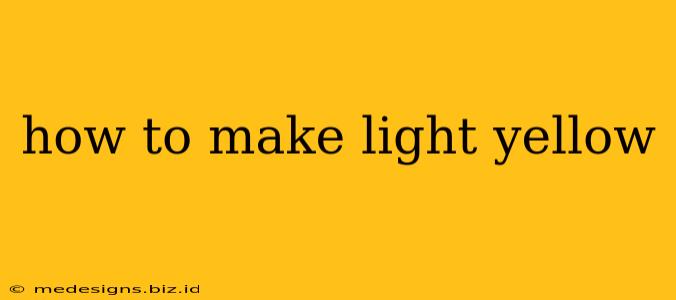Want to achieve that perfect, delicate light yellow hue? Whether you're mixing paints, crafting with dyes, or even baking, knowing how to achieve the right shade of light yellow is crucial. This guide will walk you through various methods to create your desired light yellow, covering different mediums and offering helpful tips for success.
Understanding the Basics of Light Yellow
Light yellow sits on the lighter end of the yellow spectrum. It's a versatile color, often described as pale yellow, lemon yellow, or even a creamy yellow, depending on its undertones. The key to making a light yellow is to start with a base color and gradually add white or another lighter color to achieve the desired lightness and warmth.
Key Ingredients for Creating Light Yellow:
-
Base Yellow: You'll need a yellow pigment as your starting point. The type of yellow you choose will significantly impact the final result. Different yellows possess varying undertones (e.g., warm, cool) that will affect the final hue. Common options include:
- Cadmium Yellow: A vibrant, opaque yellow, ideal for bold, warmer light yellows.
- Hansa Yellow: A bright, transparent yellow, suitable for lighter, brighter shades.
- Yellow Ochre: A natural earth pigment, creating warmer, more muted light yellows.
-
White: This is your essential lightening agent. Titanium white is commonly used for its brightness and opacity.
-
Other Lightening Agents (Optional): Depending on the desired undertone, you might consider adding:
- Cream/Beige: For a warmer, creamier light yellow.
- Very Pale Green (or a touch of blue): To cool down the yellow and create a softer, pastel tone.
How to Mix Light Yellow in Different Mediums
1. Mixing Light Yellow Paint:
The method for creating light yellow paint is straightforward. Start with a small amount of your chosen base yellow on your palette. Gradually add small amounts of white, mixing thoroughly after each addition. Continue until you achieve the desired lightness. Observe the color as you mix; it's easier to add more white than to take it away.
Tips for Painting Light Yellow:
- Use a quality white: The quality of your white paint directly affects the vibrancy of your light yellow.
- Mix small batches: This prevents waste and allows for easier color correction.
- Test your mix: Before applying it to your artwork, test the color on a scrap piece of canvas or paper.
2. Making Light Yellow Dye:
Creating light yellow dye involves similar principles. Start with your chosen yellow dye and progressively dilute it with water or another appropriate solvent. The ratio of dye to solvent will determine the lightness of the final shade. Always follow the manufacturer's instructions for the specific dye you are using.
Tips for Dyeing Light Yellow:
- Use a mordant (often required): Mordants help the dye bind to the fabric and improve colorfastness. Check the instructions for your dye.
- Test on a hidden area: Before dyeing a whole garment, test a small, hidden area to make sure you're happy with the color.
3. Achieving Light Yellow in Baking/Cooking:
In baking and cooking, obtaining light yellow shades often involves using specific ingredients. For instance, using a small amount of turmeric or saffron can contribute to a gentle, warm light yellow in food. Again, start with a small quantity and gradually add more until the desired shade is achieved.
Tips for Light Yellow Food:
- Start small: It's much easier to add more than to remove.
- Consider other ingredients: Adding cream or milk can soften the color and create a creamier light yellow.
Choosing the Right Light Yellow for Your Project
The perfect light yellow depends entirely on your project and the look you are aiming for. Experiment with different base yellows and amounts of white to explore the range of possibilities and find the light yellow that best suits your artistic vision or culinary needs. Don't be afraid to experiment; creating your perfect light yellow is a fun and rewarding process!
